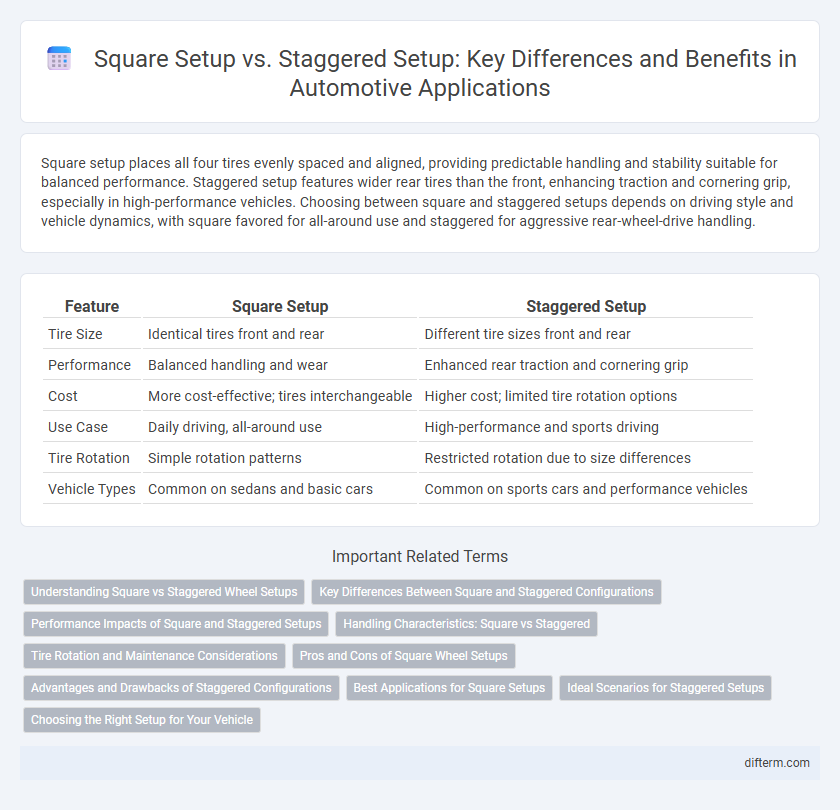Square setup places all four tires evenly spaced and aligned, providing predictable handling and stability suitable for balanced performance. Staggered setup features wider rear tires than the front, enhancing traction and cornering grip, especially in high-performance vehicles. Choosing between square and staggered setups depends on driving style and vehicle dynamics, with square favored for all-around use and staggered for aggressive rear-wheel-drive handling.
Table of Comparison
| Feature | Square Setup | Staggered Setup |
|---|---|---|
| Tire Size | Identical tires front and rear | Different tire sizes front and rear |
| Performance | Balanced handling and wear | Enhanced rear traction and cornering grip |
| Cost | More cost-effective; tires interchangeable | Higher cost; limited tire rotation options |
| Use Case | Daily driving, all-around use | High-performance and sports driving |
| Tire Rotation | Simple rotation patterns | Restricted rotation due to size differences |
| Vehicle Types | Common on sedans and basic cars | Common on sports cars and performance vehicles |
Understanding Square vs Staggered Wheel Setups
Square wheel setups feature identical tires on all four corners, providing balanced handling and simpler tire rotation, ideal for enhanced stability in performance driving. Staggered setups use wider tires at the rear and narrower at the front, improving traction and cornering grip, especially beneficial for rear-wheel-drive sports cars seeking aggressive handling. Choosing between square and staggered setups depends on the vehicle's drivetrain, intended use, and desired performance characteristics.
Key Differences Between Square and Staggered Configurations
Square setup features identical tire sizes on both front and rear axles, promoting uniform handling and easier tire rotation. Staggered setup utilizes larger rear tires compared to the front, enhancing rear-wheel traction and stability during high-performance driving. The choice impacts vehicle dynamics, with square setups offering balanced performance and staggered setups favoring rear grip and aggressive cornering.
Performance Impacts of Square and Staggered Setups
Square setups, where tires on all four corners have identical size, provide balanced handling and predictable vehicle dynamics, enhancing stability during high-speed cornering. Staggered setups feature wider rear tires compared to the front, improving rear traction and acceleration performance, particularly in rear-wheel-drive sports cars. The choice between square and staggered setups significantly affects grip distribution, tire wear patterns, and overall vehicle performance on track and street applications.
Handling Characteristics: Square vs Staggered
Square setups, featuring equal tire sizes on all four corners, offer balanced handling and predictable cornering, enhancing stability and uniform grip during aggressive driving. Staggered setups, with wider rear tires compared to the front, improve rear traction and reduce oversteer, providing better acceleration and increased stability in high-performance rear-wheel-drive vehicles. Each configuration affects vehicle dynamics differently, influencing corner entry and mid-corner balance to suit specific driving styles and performance goals.
Tire Rotation and Maintenance Considerations
Square setup features identical tires and sizes on all four wheels, simplifying tire rotation patterns and promoting even wear, which enhances tire longevity and vehicle stability. Staggered setup uses different tire sizes on the front and rear axles, complicating tire rotation since only front-to-front and rear-to-rear swaps are possible, often leading to uneven wear and more frequent replacements. Maintenance considerations for staggered setups include higher costs for replacing mismatched tires and potential limitations in tire compatibility during rotations, impacting overall vehicle performance and safety.
Pros and Cons of Square Wheel Setups
Square wheel setups offer balanced tire wear and reduced steering effort due to identical tires on all corners, improving predictability in handling. They provide easier tire rotation and cost efficiency in tire replacements since all four tires are interchangeable. However, square setups may compromise optimum grip and performance on high-powered or rear-wheel-drive vehicles, where staggered setups enhance traction and cornering stability.
Advantages and Drawbacks of Staggered Configurations
Staggered wheel setups improve traction and handling by fitting wider rear tires, enhancing grip during acceleration and cornering on high-performance vehicles. However, this configuration can increase tire wear unevenly, reduce tire rotation options, and raise replacement costs due to the use of different tire sizes front and rear. Maintenance complexity and potential impacts on fuel efficiency are additional drawbacks to consider when choosing staggered setups for automotive applications.
Best Applications for Square Setups
Square setups, where all four wheels have the same size and tire specifications, are best suited for vehicles focusing on balanced handling and predictable performance, such as sports cars and lightweight coupes. This configuration enhances cornering stability and provides uniform traction, which is ideal for dry conditions and precision driving on paved roads. Square setups also simplify tire rotation and maintenance, making them practical for performance-oriented daily drivers and track-focused vehicles.
Ideal Scenarios for Staggered Setups
Staggered setups excel in high-performance and sports cars where enhanced rear-wheel traction is crucial for aggressive cornering and acceleration. This configuration optimizes handling dynamics by fitting wider tires on the rear axle, improving stability during high-speed maneuvers and reducing understeer. Ideal scenarios include track racing, spirited driving on twisty roads, and vehicles with rear-wheel drive systems that demand superior rear grip.
Choosing the Right Setup for Your Vehicle
Square setup, featuring identical tire sizes on all four corners, enhances predictable handling and balanced wear, ideal for high-performance vehicles demanding agility. Staggered setup uses larger rear tires compared to the front, improving rear traction and cornering stability but limiting tire rotation options, commonly found in rear-wheel-drive sports cars. Selecting the right setup depends on your vehicle's drivetrain, driving style, and performance goals, with square setups favored for rotation and longevity, while staggered setups optimize grip and dynamic handling.
Square setup vs Staggered setup Infographic

 difterm.com
difterm.com